Innovation in the Caucasus – Part III – Azerbaijan
This is the third and final article in a three-part series that focuses on innovation in the three countries of the Caucasus – Armenia, Georgia, and Azerbaijan. This article begins with an examination of innovation in Azerbaijan and provides a conclusion to the series.
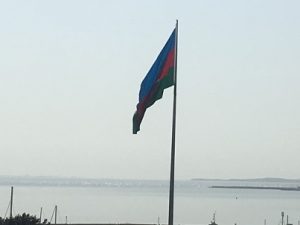
Azerbaijan Flag and the Caspian Sea
Azerbaijan
The name Azerbaijan means land of fire, derived from the Persian word for fire – azer. Since ancient times, Azerbaijan has been a land of abundant oil and natural gas, and oil for various purposes has been extracted from the area dating as far back as the 9th century A.D. For centuries the land around Azerbaijan was seen as synonymous with fire, with entire hillsides burning endlessly as natural gas seeped up through the earth’s surface and ignited. Ancient chronicles of ships in the Caspian Sea record seeing terrain on fire around the spot that is now the capital, Baku, and the area became a center for the ancient fire-worshipping religion known as Zoroastrians. Today one can see examples of this in a constantly burning landscape at Yanar Dag (Fire Mountain) near Baku, as well as at the fire temple of Baku (the Ateshgah), a former Zoroastrian Temple that is now a museum with a structure in which an eternal flame still burns.

Yanar Dag
The great city of Baku blends two other earthly elements into its profile in addition to fire. Wind is a constant companion in Baku, and the city itself derives its very name from the Persian word for wind. Baku is also perched on the deep blue Caspian Sea, which is actually an enormous, saltwater lake with no outlet to any ocean that sits below sea level. For a city blessed with abundant petroleum supplies, one would assume that the automobile would reign supreme in Baku, yet Baku is actually one of the most pedestrian-friendly capital cities in the world. The waterfront area of Baku is spanned by a 16-kilometer-long pedestrian-only zone known as the Bulvar (Boulevard). Unlike some other waterfront walking areas, the Bulvar contains multiple sets of parallel walking paths, with some immediately next to the sea while others are slightly inland and sheltered by trees to provide shade from the intense Middle Eastern sun. Between the Bulvar and the other parts of Baku runs a busy ring road, but there are numerous pedestrian tunnels that allow one to cross back and forth easily between these areas. In the central city part of Baku, one finds even more pedestrian-only areas, with parks, fountains, shops, and restaurants that are all easily accessible on foot.
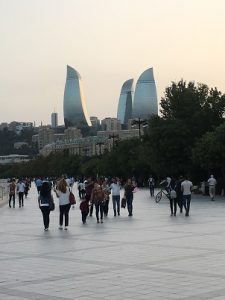
Pedestrian-Friendly Bulvar in Baku with Flame Towers in Background
One might imagine that much of the innovation surrounding Azerbaijan centers around the oil industry, though in my explorations around the country I found several other examples of innovation.

Oil Wells outside Baku
Sheki Khan Palace
Given its proximity to modern-day Iran and what was once the Persian Empire, Azerbaijan over the centuries has absorbed a great deal of influence from its southern neighbor. In the late 1700s, the Persian Empire ruled over all of what we now call Azerbaijan and extended its influence into modern-day Georgia as well. In the northwest corner of Azerbaijan, about 100 kilometers from the border with Georgia, sits the historic town of Sheki. Today it is known for its extremely sweet dessert treat called halvasi (Azerbaijanis will drive for hours to get a genuine Sheki halvasi), but in the past Sheki was the site of the summer palace of the Sheki Khan (Muhamed Hasan) who ruled over the region. Originally built in 1797, the palace was restored several times in the 20th century and is a masterpiece of Persian architecture. The most stunning characteristics of the palace are the stained glass windows, which project an array of beautiful colors on the interior floors and walls of the palace as the sun strikes them at different angles throughout the day. The palace architect used stained glass to provide light to the various rooms of the palace without allowing in much heat (like a tinted window in the modern era), thus serving a dual purpose (decoration and temperature control). The clay floors in the palace were also designed to keep the palace rooms cool in the summer and warm in the winter.
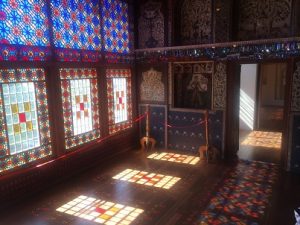
Sheki Khan Palace
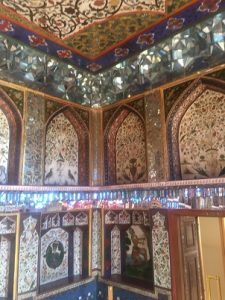
Sheki Khan Palace
Innovation Perspective – A quick way to engineer innovation into a product is to create a single item that has multiple functions. In other words, if a product can prove useful for several different functions without requiring any changes, then that product will certainly be considered more innovative than something that only serves a single purpose. The stained-glass windows at the Sheki Khan Palace serve a decorative function, rendering the rooms of the palace sufficiently magnificent for the ruler of the region while also regulating temperature in the typically hot climate of the area. Likewise, the clay flooring proved to be warm in the winter and cool in the summer, thus meeting the needs of the residents of the palace. When designing a new product or solution, an innovator should always search for ideas that generate multiple uses. One of the most intriguing dual-use items I found in Azerbaijan was in a place where one does not often expect to find innovation. At the Yeddi Gumbaz mausoleum and cemetery in central Azerbaijan, there are numerous gravestones in a field surrounded several mausoleums from the early 1800s. Sculptors designing the gravestones cut round shapes in the top of the stones so that when it rains these indentations fill with water. It is thought that wild animals living nearby in such a dry climate would be able to use these small pools of water to drink, which allows the gravestone to serve a larger purpose than simply showing the location of a buried loved one.

Tombstone
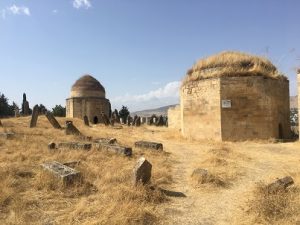
Yeddi Gumbaz Mausoleum
Sheki Caravanserais
As with the other countries of the Caucasus region, Azerbaijan was a key point on the ancient Silk Road trade route. As caravans of traders with their camels and other beasts of burden passed along the Silk Road, an important support facility for these voyagers was the caravanserai, which is Persian for “Caravan palace.â€Â The town of Sheki at one point had seven different caravanserais spread throughout the town, signifying the importance of this town on the Silk Road and the large number of caravans passing through the area at any given time. A caravanserai was laid out basically as a large traveler’s inn but it was designed with very specific requirements. First, the structure required a large central courtyard with an entrance sufficiently wide to allow fully-laden camels to enter, but small enough so that it could be closed at night for protection. Within the courtyard would be sources of water for the animals on the ground level, as well as open areas where the animals could take forage. The caravanserai also needed lockable areas on the lower level where a trader could secure his goods while staying at the facility. On the second level of the structure, one would find the rooms for the traders to rest, obtain news, and recharge before heading back along the Silk Road. Caravanserais appear all along the Silk Road, and one of the best preserved is in Sheki and is now used as a hotel.
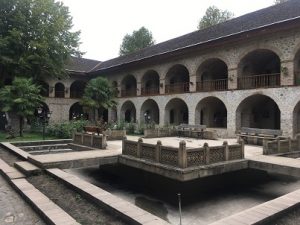
Sheki Caravanserai
Innovation Perspective – An innovator working on a longer-term innovation project has some similarities to a trader traveling along the Silk Road. The innovator’s journey is usually a long one, as major breakthroughs often require the investment of a large number of resources and a great deal of time to accomplish. An innovator should think about his or her journey on the project in the way that the Silk Road trader worked with the caravanserai to obtain support along the way. An innovator needs to have an idea of a place to stop along the journey in the sense that one cannot work 24 hours a day, 7 days a week on the same project. One always needs a break from the intense focus on the project, and often times this break will allow one to refresh one’s thinking and possibly come up with even more creative approaches to solving problems on the project. When taking a break from the project, the innovator also needs to think about his or her colleagues or teammates and ensure that they, like the camels in the caravan who are so instrumental to carrying the burden on the journey, are able to take a break and refresh themselves. The innovator should also be careful to protect the intellectual capital of the project while on a break, just as the trader secures his wares in locked rooms in the caravanserai. Threats to the project may come from competitors who obtain information from a team member while one’s defenses are down during a lull period on the project, or may come from internal forces who see the delay as an opportunity to convince senior management that resources could be better spent on other efforts.
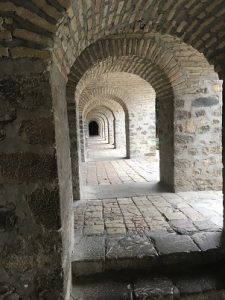
Sheki Caravanserai
Alfred Nobel in Baku
Today Alfred Nobel is best known for the endowment he created in his will in 1895 that awards annual prizes in six categories (Physics, Chemistry, Physiology or Medicine, Literature and Peace) to esteemed individuals working in these six fields (a seventh category, Economics, was added in 1968 by Sweden’s central Bank). One often hears that Nobel’s primary source of wealth was derived from his patent on dynamite, but Nobel was also one of the world’s earliest oil barons. One of Nobel’s first business ventures was in gun manufacturing for the Russian Tsar, with factories in Sweden and in Russia. In 1873, Alfred’s older brother Robert first visited Azerbaijan in search of sources of walnut trees, which would provide hardwood for the rifle stocks needed in the factory. While in Baku, Robert noticed that speculators were buying up plots of land outside of town as part of a nascent oil boom. Robert bought a parcel and hired a worker to dig a well, and the well soon struck oil. Robert telegraphed his brothers Alfred and Ludwig and suggested that they stop focusing on the rifle business and move to Baku to join in the oil boom. The Nobels would go on to buy up many wells and establish a small village, known as Villa Petrolea, in the Black City area of Baku (named as such because of the presence of oil nearby). They then built an oil production company named Branobel that at one point in time was the second largest oil company in the world, just behind Rockefeller’s Standard Oil company. The logo for Branobel featured the famous Zoroastrian Fire Temple in Baku, highlighting the brothers’ respect for local religions and traditions.
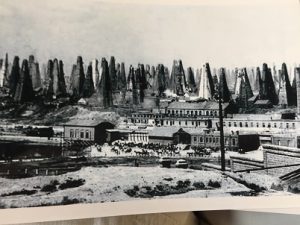
Oil Derricks in Baku during the Oil Boom
Innovation Perspective – Although they experienced the typical ups and downs of the armaments business (high production rates when a country is at war or gearing up for war, low production rates during peacetime), the Nobel brothers nonetheless were successful with their armaments company, Bofors, that remains a key weapons manufacturer even today. Yet the Nobels were willing to change their focus quickly once they saw the opportunities presented by the nascent oil industry in Baku, and poured their attention and resources into the new endeavor. They could have simply obtained walnut trees and returned to their armaments factories in Sweden and Russia, but they took a chance on a new industry and were rewarded handsomely.
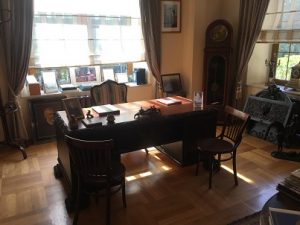
Alfred Nobel’s Office in Baku
For the modern innovator, this type of willingness to make quick changes in direction is an important trait. An innovator may be in the middle of a project in which he or she has invested a great deal of time and energy, only to stumble across a completely new opportunity while working on the other project. If the new opportunity is sufficiently promising, then the innovator needs to have the courage to shift resources and attention towards the new endeavor. The old project may not need to be completely abandoned, but work on it can be delayed or slowed down so that one does not miss out on the small window of the new opportunity. One should look at the old project as a stepping stone towards the new idea, even if the two concepts do not seem to be related at first glance. The Nobels might not have discovered the boom town of Baku had they not been in the armaments business searching for wood supplies, even though guns and oil are not related industries.

Nobel Company Logo with Fire Temple
Mendeleev in Baku
In addition to the Nobel brothers’ sojourn in Baku, another famous Baku resident was the Russian scientist Dmitri Mendeleev, who would go on to invent the famous periodic table of the elements – one of the greatest scientific discoveries of all time. Mendeleev’s periodic table identified the known elements in the universe in 1871 and successfully predicted the existence of elements that scientists would only discover decades later. Yet Mendeleev did not devote his efforts solely to the study of esoteric scientific phenomena, he also spent time working on the economic and industrial needs of Russia. Mendeleev researched the coal and petroleum industries and traveled to Baku where he worked in a small laboratory for one of the oil barons. His lab happened to be right next door to the famous Zoroastrian Fire Temple, just outside of town. In 1880, Mendeleev proposed and designed an oil pipeline that would run from Baku to Batumi, a distance of over 500 miles through varied terrain. Batumi, a port on the Black Sea on Georgia’s coast, had ports where tankers could load petroleum and transport it through the Bosporus Straits and into the Mediterranean Sea to the rest of the world.
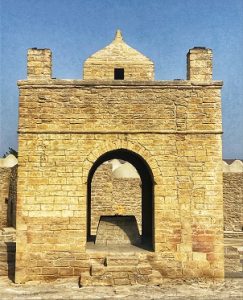
Fire Temple in Baku near Mendeleev’s Laboratory
Innovation Perspective – As innovators we are often torn between the worlds of searching for practical solutions that are easy to implement versus trying to find truly groundbreaking concepts that can disrupt marketplaces because of their novelty. While the latter are the most valuable and would help cement our place in corporate lore, these types of innovations are extremely difficult to come by and may only happen once in a career, if at all. More practical innovations, that may be smaller in scale and less impactful, are easier to identify and implement. The example of Mendeleev shows that it is important to place emphasis on both items. One can imagine that a mind as powerful as Mendeleev’s, able to ferret out never-before discovered secrets of all of the elements in the universe, would be ill-suited to invest time in developing an oil pipeline. Yet Mendeleev did just that, and also seemed to relish his work supporting Russia’s industrial development perhaps as much as the pure scientific work that would make him famous. According to Bernadette Bensaude-Vincent, Professor of the History and Philosophy of Science at the University of Paris X Nanterre in France, Mendeleev “may have devoted more time to questions of national economy than to pure chemistry [and …] was able to combine his lifetime interests in science and industry and to achieve one of his main goals: integrating Russia into the Western world.â€

Oil Industry Infrastructure in Baku – During Mendeleev’s Era
The example of Mendeleev focusing on economics and not just pure chemistry has interesting parallels to a recent assessment of Quantum Theory in physics by Professor Simon Jolly, a Lecturer in the Department of Physics & Astronomy at University College London. Speaking on the BBC Radio 4 program In Our Time, Jolly asserts that a good scientific theory should be able to do two things well. First, it needs to be able to generate predictions based on a set of variables. Second, the theory needs to be able to explain why its prediction was or was not accurate. Jolly posits that Quantum Theory performs the first task quite well, as its complex mathematical models are extremely precise and can generate testable hypotheses and predict outcomes in a reliable manner. However, he continues, Quantum Theory does not excel at the second task because of the measure of uncertainty in its explanations of predictions, such as a particle not really being a particle, but, rather, acting as a wave. As innovators, this dichotomy is a good one to remember as it is not sufficient just to come up with a great idea. An innovator needs to be able to translate that great idea into something that can be implemented in the real world, whether that is as a process change or a new product. Perhaps Mendeleev stayed grounded in his work because he did not limit himself to only working on theory but also found ways to work on tactical-level projects that had an immediate benefit to those around him. This is an excellent model for the innovation practitioner to follow.

Oil Industry Infrastructure near Baku Today
Palace of the Shirvanshahs
Baku is a city of contrasts, as one can see in one direction gleaming, modern glass skyscrapers in the shape of flames (the Flame Towers) and in the other direction the ancient city walls of the Old City of Baku. The most prominent structures in the old city are the Maiden’s Tower and, at the top of a hill overlooking the area, the stone edifice of the Palace of the Shirvanshahs. The palace was first constructed in the 15th century A.D. by the Shirvan Shahs who ruled the area from the 9th century A.D. to the 16th century A.D. The palace itself consists of a main palace building, a mosque for the Shah himself, a mausoleum, a reservoir, and a bath house. Located on high ground inside the city’s walls, the palace has seen its share of conflict over the centuries, and bullet holes are quite apparent in the exterior walls near the entrance. The palace has undergone several renovation efforts, starting in the 1920s during the Soviet occupation, followed by a conversion of the ruins into a museum in 1964. The most recent renovation occurred in 2006 along with a UNESCO World Heritage designation. Many parts of the palace were rebuilt, and the interior contains an odd mix of museum exhibits and a throne-room multimedia experience that, according to some critics, does not suit the structure.
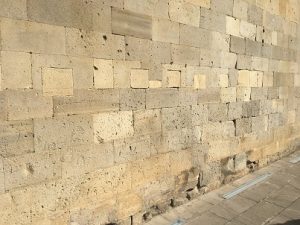
Bullet Holes in Palace Walls
The renovation of the Palace of the Shirvanshahs highlights a larger debate in the field of archaeology in terms of whether ancient sites should be rebuilt using modern technology so that visitors to the old sites can experience them in a similar way to how their ancestors would have visited the location hundreds of years ago. Some scholars want every stone to be either left in place on the ground after a destructive event (such as an earthquake) or, if reconstruction takes place, only the original stones should be used in the edifice. In other words, no newly-quarried stone or modern steel supports should be used to re-create a structure from the past. Others see the value of reconstruction because it brings these sites alive to the modern visitor in a way that a pile of stones cannot provide. Having visited the Palace in Baku, it seems as though the reconstruction, despite some minor flaws, was the best way to demonstrate to modern visitors the power and faith of the Shirvan Shahs and gives the visitor the ability to walk briefly in the steps of the Shah in his palace and mosque and get a sense of the size and scope fo the Shah’s power. Nearby the Palace are ruins of ancient bathhouses that, while interesting to see from afar, do not provide the same experience as one cannot walk through them given their deteriorated state.

Palace of the Shirvanshahs
In neighboring Armenia there is an excellent example of the two different approaches to conservation of ancient sites. In the village of Garni, a short drive to the east of Yerevan, sits an ancient structure that looks like it was either deposited into Armenia by aliens or Hollywood producers. The site is the Temple of Garni, a small temple perched on a steep cliff that overlooks the Azat River with the soaring Gegham mountains in the background. The Temple, built around 77 A.D., surprises visitors because it is constructed in Greco-Roman style, with a triangular roof, rectangular proportions, and Ionic stone columns. Scholars believe the temple was dedicated to the sun-god based on its solar alignment. At the solstice, it is believed that a hole in the roof permitted the sun’s-rays to strike a pool of water in the center of the temple which would then reflect onto a statue of the sun-god at the back of the building. The temple collapsed in an earthquake in 1679 and lay in ruins for centuries until 1975, when Soviet officials decided to rebuild it (they liked the classical attributes of the building despite their distaste for religion). Where particular pieces of stone could not be found, the architects used local stone of a different color so visitors can clearly see which parts are original and which are newly restored. The end result is a site that is heavily visited by tourists and one of the most amazing ancient temples in the region.

Garni Temple, Armenia
The magnificently-restored Garni Temple contrasts sharply with another Armenian Temple located to the west of Yerevan. The Zvartnots Temple was built in the 7th century A.D. and was used until the 10th century A.D., though no sources exist to describe what happened to the temple at that time (it likely succumbed to one of the region’s frequent earthquakes). Archaeologists first discovered the ruins of the temple in 1901, and a few years later the Armenian Architect Toros Toramanian assembled a handful of columns at the site to create a partial reconstruction of what he thought the building would have originally looked like. The site is open-air, with maybe a dozen columns and a few arches on display on a large pedestal, though the majority of the stones from the structure can still be seen laying on the ground, covered in grass and dirt. Images of the original design of the Zvartnots Temple are quite important to Armenians and appear on one of their banknotes. The Temple was also the inspiration for the design of the control tower at Armenia’s Zvartnots International Airport, which is just a few miles away from the site. Unfortunately, the ruins of the Zvnartnots Temple do not provide the same impact as one would feel in a more thoroughly-restored site. While the size of the structure would make it difficult and expensive to restore, one cannot help but think that such a structure would be a magnificent and inspirational edifice for the people of Armenia and foreign visitors.
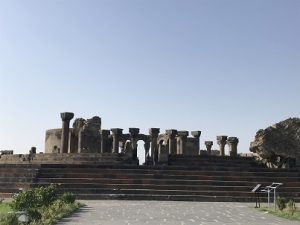
Zvartnots Temple, Armenia
Innovation Perspective – The lesson of these three temples: two full reconstructions and one partial reconstruction, serves as a reminder to the innovator of the importance of physical demonstrations when trying to convey information to decisionmakers or other influencers concerning one’s innovation work. For innovation work involving a new product, there is no substitute for a physical prototype where possible. In the case of a digital innovation, one should be able to produce a hands-on demonstration version of the solution. Building attractive charts that explain what one is going to accomplish is quite different from providing some form of the solution. It may not be possible in all instances to create highly-complex versions of one’s ultimate innovation, but any steps one can take in the direction of a tangible solution will make that innovation project more likely to succeed.
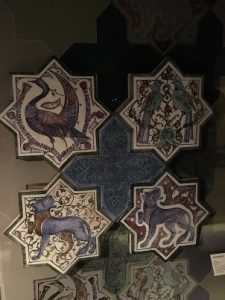
Reconstructed Tiles in Palace of Shirvanshahs
Innovation in the Caucasus – Conclusion
I left these three countries pondering what attributes they possessed that had allowed them to emerge as independent nations while surrounded by powerful empires on all sides. All three countries had a brief taste of independence just after World War I (in 1918), but this independence was short-lived as the Bolsheviks invaded and incorporated these countries into the Soviet Union, where they would remain under outside control for over 70 years. It was interesting to observe that all three countries commemorated this brief independence period even though it only lasted a couple of years. It was as if the people of this region had a taste of freedom and knew that they would have it again at some point in the future.
Thinking about the characteristics that these three countries shared which helped them to survive occupation and emerge as free countries in 1991, I recognized that innovators could benefit by thinking about these same attributes in their programs:
Common Culture
Each country has a strong sense of nationhood that is manifested in their culture, language, religion, and outlook. Each country defends its unique national language with tremendous pride. The complex alphabets of the Armenian and Georgian languages, as well as the complexity of the grammar of these languages, make them very complex to learn but the countries defend their languages with a great deal of effort. Azerbaijan revels in its unique language, with the mix of Persian words and Roman-like alphabet. Each country also places cultural figures in revered positions. Poets, artists, writers, composers, architects, and others figures who played a role in establishing or sustaining the unique culture of one of these countries were honored with statues or had streets named after them. Although a handful of military figures and politicians were included in the national pantheon, for the most part these countries focused on those individuals whose contributions were to the nation’s cultural heritage moreso than its political or military heritage. The most famous street in Tbilisi, Georgia, for instance, is named after their national medieval poet, Shota Rustaveli. Rustaveli Avenue was originally named Golovin Street, after the Russian Governor-General of the Caucasus Region, Yevgeny Aleksandrovich Golovin. During the Soviet era, Georgians used an informal word of mouth campaign to change the name to Rustaveli, despite Russian desires to keep the name as Golovin. Eventually the authorities relented and allowed the name change to be formalized.
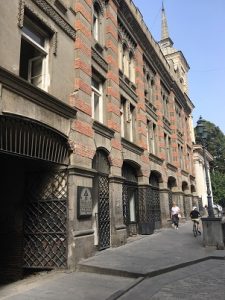
Rustaveli Avenue, Tbilisi
For the modern innovator, honoring those who generate new ideas would be the equivalent of nations honoring their cultural contributors. Rather than solely recognizing achievements in terms of achieving sales quotas or winning new contracts, a company should also consider honoring those workers who come up with new ideas to make processes work more efficiently, or who devise modifications to products that allow the company to deliver a new offering to the marketplace.
Pride in Mission
Each of the three countries in the Caucasus has a clear sense of national mission and takes pride in that mission. That mission is maintaining independence and surviving in a tough neighborhood while protecting their national heritage. Residents of these countries take that mission seriously, and I never encountered anyone who spoke negatively about their country’s mission. This is quite a contrast from what an innovator might experience in a corporate environment in which executives set stretch goals that seem impossible for the average worker to comprehend or attain. In the case of a stretch goal, one needs to ensure that there are numerous achievable steps along the way that can be attained to give all of the team members a sense of accomplishment and a level of confidence that the group is moving in the direction of achieving the larger objective. For the Caucasus countries, this happens every day. Every day that a resident walks past Freedom Square in Tbilisi, or sees Mother Armenia in Yerevan, or sees the Flame Towers in Baku, he or she knows that the country is surviving and even thriving in a challenging world.
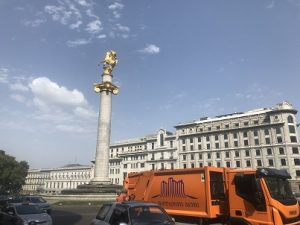
Freedom Square, Tbilisi
Resilience
During my time in the Caucasus I never heard a complaint from any residents of these countries lamenting the geographic position into which they had been placed. No one cursed their lack of natural resources or their proximity to enemies. No one felt sorry for themselves because of the deprivations of the Soviet era. No one wailed about a slow admission process to NATO or the EU. Rather, they understood that they were in a unique period in their country’s history in terms of being independent and they were convinced that they would protect that independence against any threats. When asked what they would do should the Russians try to advance further into Georgian territory via the already-occupied South Ossetia, Georgians responded that they would “handle it.â€
This may be another reason why the Georgians decided not to tear down the Russian-Georgian Friendship Monument on the Georgian Military Road. The monument is a stark reminder to all Georgians of the danger in trusting their security to a third party. In that case, they received a pledge from the Tsar to defend them from attack yet when the Persian Empire invaded, Russia did not send troops to support the Georgians, who ended up being defeated and occupied by the Persian Army. The closest thing I saw to a monument to real friendship in Georgia was a small statue of U.S. President Reagan in Rike Park in downtown Tbilisi. The statue, unveiled in 2011, was accompanied by the opening of the Reagan Freedom Center in Tbilisi, which is dedicated to promoting democracy, democratic institutions, security, and Georgian-U.S. relations.
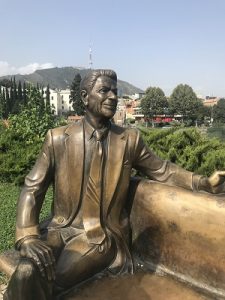
Reagan Statue in Tbilisi
Georgians, Armenians, and Azeris demonstrate a toughness and resilience that rivals the ferocity of any other nationality on the planet. This reminds me of the mindset an innovator must possess when taking on an entire industry or marketplace with just a small team of individuals. An innovator may not always have the most resources to complete a project, but with perseverance he or she can find a path to success.
Sources:
https://www.azer.com/aiweb/categories/magazine/ai102_folder/102_articles/102_oil_chronology.html
https://en.wikipedia.org/wiki/Yanar_Dag
https://en.wikipedia.org/wiki/Ateshgah_of_Baku
https://en.wikipedia.org/wiki/Palace_of_Shaki_Khans
https://en.wikipedia.org/wiki/Yeddi_Gumbaz_mausoleum
https://en.wikipedia.org/wiki/Caravanserai
https://www.nobelprize.org/prizes/facts/nobel-prize-facts/
https://en.wikipedia.org/wiki/Alfred_Nobel
https://en.wikipedia.org/wiki/Branobel
https://en.wikipedia.org/wiki/Dmitri_Mendeleev
https://www.britannica.com/biography/Dmitri-Mendeleev
https://en.wikipedia.org/wiki/Baku-Batumi_pipeline
https://www.bbc.co.uk/programmes/b09zt3mr
https://en.wikipedia.org/wiki/Palace_of_the_Shirvanshahs
https://www.smithsonianmag.com/travel/whats-ancient-roman-temple-doing-armenia-1-180967756/
https://en.wikipedia.org/wiki/Temple_of_Garni
https://www.atb.am/en/armenia/sights/christ/zvartnots/
https://en.wikipedia.org/wiki/Rustaveli_Avenue
https://en.wikipedia.org/wiki/Yevgeny_Golovin
https://www.tabula.ge/en/story/70216-ronald-reagan-statue-opened-in-tbilisi
Wait! Before you go…
Choose how you want the latest innovation content delivered to you:
- Daily — RSS Feed — Email — Twitter — Facebook — Linkedin Today
- Weekly — Email Newsletter — Free Magazine — Linkedin Group
 Scott Bowden is founder and CEO of Bridgeton West, LLC, a consulting firm focusing on historical innovation. Scott previously worked for IBM Global Services and the Independent Research and Information Services Corporation. Scott has a PhD in Government/International Relations from Georgetown University.
Scott Bowden is founder and CEO of Bridgeton West, LLC, a consulting firm focusing on historical innovation. Scott previously worked for IBM Global Services and the Independent Research and Information Services Corporation. Scott has a PhD in Government/International Relations from Georgetown University.
NEVER MISS ANOTHER NEWSLETTER!
LATEST BLOGS
Credit Card Shenanigans
It must be great to be in the credit card business in the United States. Demand is relatively inelastic and regulation is lax, so you can charge whatever you want for an interest rate, increase your fees once or twice a year, and make additional money off cash withdrawals and foreign exchange transactions.
Read MoreBuilding an Experience
As people become ever more immune to traditional advertising and marketing, branding will become more important. Branding is all about building an emotional connection with customers. Making the decision to follow a strategy focused on building a brand is not without peril, however, as it means that you will have to choose to not do certain things, like pursue a low price strategy.
Read More- « Previous
- 1
- …
- 4,132
- 4,133
- 4,134




